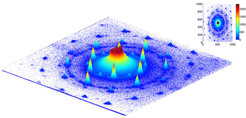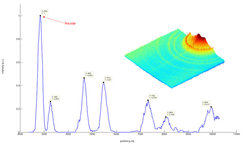
Large Scale Facilities
REGAE is collaborative effort between the Miller group and the DESY Machine Physics group to develop new concepts exploiting relativistic electrons for the direct observation of atomic motions. REGAE is unique in that it is currently the only machine of its kind using a rebunching cavity to attain the shortest possible electron pulse on target, or brightest possible source for a given electron source/photocathode. The current design is capable of 7 femtosecond (rms) electron pulses with up to 107 electrons per pulse with spatial coherence of over 30 nm. This system has sufficient spatial and temporal resolution to capture the fastest possible atomic motions for systems as complex as proteins. The higher penetration depth of relativistic electrons makes it possible to use thicker samples that are perfectly matched to both typical laser excitation volumes and to avoid peak power limits in exciting samples on femtosecond time scales without introducing multiphoton ionization artifacts. This system will be used in combination with the latest advance in nanofluidics to provide direct observations of atomic motions governing solution phase chemistry – where most chemistry occurs. In addition, it is anticipated that this new source will open up the study of protein systems and classes of membrane bound proteins that cannot be crystallized or only form nanocrystals.

This unique source is also being modified to provide real space imaging with specifically engineered electron optics to convert REGAE to a relativistic Transmission Electron Microscope (rel-TEM). There are many problems that result entirely from nonlinear spatial-temporal correlations. Living systems represent one important such class of problems. REGAE is being specifically designed to enable the study of living cells with 1 nm spatial resolution or better to literally watch a cell in action at the molecular level. Problems such as DNA transcription, cell division, and intracellular transport, as just three representative problems that are now amenable to direct observation at the single molecule level. Similar processes are being studied using single molecule spectroscopy methods with recently developed super-resolution microscopy methods with nm tracking capabilities. There is an important distinction in that the prospect of directly imaging molecular motions with electrons will give the full spatial correlation, i.e., all the relevant molecular motions, not just a single point correlation or centroid position. There are inherent spatial and temporal correlations that impart life into living systems. These are now observable at the molecular level in their full splendor.

In addition to the new experimental capabilities of REGAE, this system is also being used to help advance the photoinjection system and timing for the European XFEL. New photocathodes and rf synchronization schemes are being explored at REGAE, along with studies of new concepts in direct laser driven particle acceleration. Due to the much higher gradients possible with laser acceleration, this approach is seen as the future of particle accelerators, however, the spatial inhomogeneous field problem has to be understood and controlled to make this next step. Imagine a table top XFEL. REGAE is giving the tools to help realize this vision.

